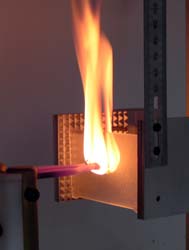
Posted to News on 22nd Nov 2007, 10:59
Beware of changing regulations for electrical equipment
Terry Spriggs, a product specialist at Hylec-APL, explains why designers operating in the industrial sector should take note of changes to European regulations covering domestic appliances.

In 2008 domestic appliances available on the market in Europe will have to conform to EN 60335-1: 2002 (Specification for safety of household and similar electrical appliances. General requirements) and, if applicable, the latest relevant device-specific part 2 of the standard. Manufacturers still operating to the 1995 standard will not obtain product approval so conformance to the ever more stringent requirements is essential.
One of these changes could literally mean the difference between life and death, so industry needs to be aware that the regulations applying to domestic goods are there for a good reason, and could soon be expected of industry - a fire started by a sub-standard terminal block or electrical fitting, for example, could be avoided if manufacturers took heed of some of these changes.
In 2005, the updated EN 60335-1 standard for the safety of household appliances came into full force. The first major update of the domestic appliance safety regulations since 1995, the new rules required manufacturers to adopt more stringent fire safety and electrical isolation standards. A failure to properly understand these standards by OEMs can now lead to costly delays in bringing products to market for domestic goods, yet selecting the right components and designs to ensure compliance need not be costly or challenging for domestic goods manufacturers, or for industry.
Fire resistance
One of the essential changes to the regulations concerns the fire resistance of components. All electrical components must be able to withstand exposure to a 750degC glow wire, with any flame that occurs as a result of this exposure being self-extinguished within two seconds. This is a far tougher test than the outgoing standard, which allowed a 30-second period for any flame to be extinguished.
That two-second permissible burn time is a particularly demanding requirement, essentially meaning that components must produce no flame at all, since it is difficult for self-extinguishing materials to act effectively in such a short time. To add to the challenge of compliance, components must also be halogen-free and low-smoke. Components likely to be affected by the new flammability rules are any where plastic materials come into contact with conductors, including enclosures, switches and terminal blocks.
In order to comply with the new regulations, manufacturers of these products are having to adopt new materials in their designs. Ceramic materials give the highest degree of heat and flame resistance, but their high cost makes them unsuitable for many price-sensitive high-volume applications. Fortunately for appliance manufacturers, there are cost-effective alternatives available. Modern nylon-based materials can deliver appropriate performance at a relatively small price premium over non-compliant materials.
Recommendation
Although a supplier of many different components to a variety of industries, suppliers of approved and tested components such as Hylec-APL now recommend the use of components that pass the stringent domestic regulations for safety reasons. Items typically include PCB mounted terminal blocks, nylon pillar terminal blocks and domestic appliance connectors from manufacturers such as Metalluk, ITW Elettro-Gibi, and micro switches from Cherry.
The new EN 60335-1 standard also includes revised tables for creepage and clearance limits. Clearance distances refer to insulation distances through air - the shortest distance between to conductive elements. Creepage distances are measured along the insulated surface between the two conductors. With the new, more stringent limits, designs become far more sensitive to small manufacturing errors. Inserting a wire too far into a terminal block can lead to the conductor protruding from the other side, potentially breaching clearance limits.
Tight quality control during assembly is one strategy to avoid falling foul of issues like these, but there are also component selections that can help to prevent these problems occurring. Barrier inserts are a simple way to completely eliminate over-insertion of conductors into terminal blocks, ensuring that clamping always occurs on the conductor and that nothing protrudes through the rear of the block. Barrier inserts also help to cut manufacturing costs by increasing assembly speed.
These changes are the most significant in domestic appliance safety for some time. Failure to comply with any applicable rules could be extremely costly - while the corrective action required may be relatively simple, manufacturers will not be allowed to sell their products until the work is complete and testing repeated, potentially losing weeks or months of sales during the crucial product launch period. Designers should take the time now to study the new regulations and make sure all components they are sourcing themselves - and all those coming in from overseas suppliers - comply with the new rules.
6 Stanton Close
Finedon Road Industrial Estate
NN8 4HN
UNITED KINGDOM
+44 (0)1933 234400






























